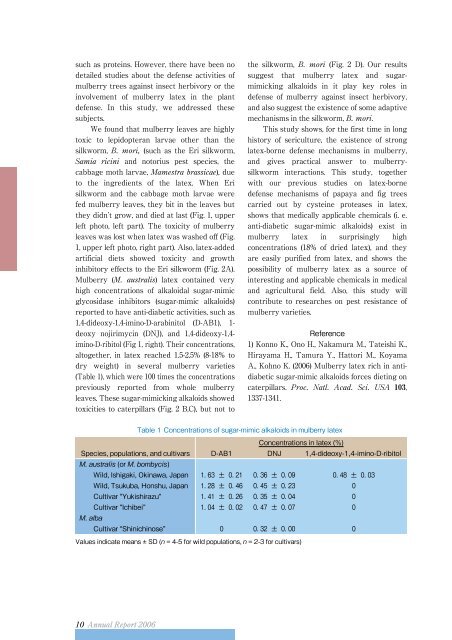Annual Report 2006
Annual Report 2006
Annual Report 2006
Create successful ePaper yourself
Turn your PDF publications into a flip-book with our unique Google optimized e-Paper software.
such as proteins. However, there have been no<br />
detailed studies about the defense activities of<br />
mulberry trees against insect herbivory or the<br />
involvement of mulberry latex in the plant<br />
defense. In this study, we addressed these<br />
subjects.<br />
We found that mulberry leaves are highly<br />
toxic to lepidopteran larvae other than the<br />
silkworm, (such as the Eri silkworm,<br />
and notorius pest species, the<br />
cabbage moth larvae, ), due<br />
to the ingredients of the latex. When Eri<br />
silkworm and the cabbage moth larvae were<br />
fed mulberry leaves, they bit in the leaves but<br />
they didnt grow, and died at last (Fig. 1, upper<br />
left photo, left part). The toxicity of mulberry<br />
leaves was lost when latex was washed off (Fig.<br />
1, upper left photo, right part). Also, latex-added<br />
artificial diets showed toxicity and growth<br />
inhibitory effects to the Eri silkworm (Fig. 2A).<br />
Mulberry ( ) latex contained very<br />
high concentrations of alkaloidal sugar-mimic<br />
glycosidase inhibitors (sugar-mimic alkaloids)<br />
reported to have anti-diabetic activities, such as<br />
1,4-dideoxy-1,4-imino-D-arabinitol (D-AB1), 1-<br />
deoxy nojirimycin (DNJ), and 1,4-dideoxy-1,4-<br />
imino-D-ribitol (Fig 1, right). Their concentrations,<br />
altogether, in latex reached 1.5-2.5% (8-18% to<br />
dry weight) in several mulberry varieties<br />
(Table 1), which were 100 times the concentrations<br />
previously reported from whole mulberry<br />
leaves. These sugar-mimicking alkaloids showed<br />
toxicities to caterpillars (Fig. 2 B,C), but not to<br />
the silkworm, (Fig. 2 D). Our results<br />
suggest that mulberry latex and sugarmimicking<br />
alkaloids in it play key roles in<br />
defense of mulberry against insect herbivory,<br />
and also suggest the existence of some adaptive<br />
mechanisms in the silkworm, .<br />
This study shows, for the first time in long<br />
history of sericulture, the existence of strong<br />
latex-borne defense mechanisms in mulberry,<br />
and gives practical answer to mulberrysilkworm<br />
interactions. This study, together<br />
with our previous studies on latex-borne<br />
defense mechanisms of papaya and fig trees<br />
carried out by cysteine proteases in latex,<br />
shows that medically applicable chemicals (i. e.<br />
anti-diabetic sugar-mimic alkaloids) exist in<br />
mulberry latex in surprisingly high<br />
concentrations (18% of dried latex), and they<br />
are easily purified from latex, and shows the<br />
possibility of mulberry latex as a source of<br />
interesting and applicable chemicals in medical<br />
and agricultural field. Also, this study will<br />
contribute to researches on pest resistance of<br />
mulberry varieties.<br />
Reference<br />
1) Konno K., Ono H., Nakamura M., Tateishi K.,<br />
Hirayama H., Tamura Y., Hattori M., Koyama<br />
A., Kohno K. (<strong>2006</strong>) Mulberry latex rich in antidiabetic<br />
sugar-mimic alkaloids forces dieting on<br />
caterpillars. 103,<br />
1337-1341.<br />
Table 1 Concentrations of sugar-mimic alkaloids in mulberry latex<br />
Concentrations in latex (%)<br />
Species, populations, and cultivars D-AB1 DNJ 1,4-dideoxy-1,4-imino-D-ribitol<br />
(or )<br />
Wild, Ishigaki, Okinawa, Japan <br />
Wild, Tsukuba, Honshu, Japan <br />
Cultivar Yukishirazu <br />
Cultivar Ichibei <br />
<br />
Cultivar Shinichinose <br />
Values indicate means SD ( = 4-5 for wild populations, = 2-3 for cultivars)













